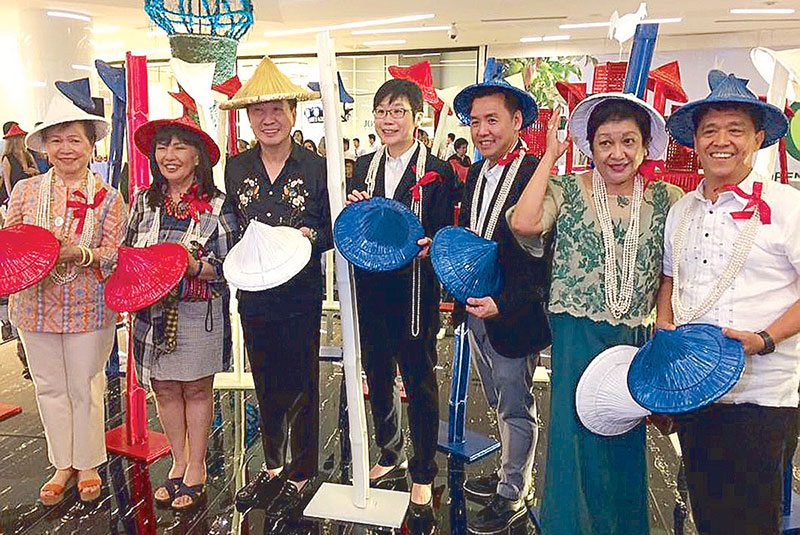Arte Filipino’ is Rachy Cuna’s ode to his heritage

At the opening of Arte Filipino are (from left) Filipino Heritage Festival Inc. president Mita Rufino, SM’s Millie Dizon, Rachy Cuna, Singapore Ambassador Kok Li Peng, SM’s Perkin So, Filipino Heritage Festival Inc. treasurer Chichi Salas and NCCA executive director Rico Pableo Jr. Photo by Büm Tenorio Jr.
Like the bamboo that is ubiquitous in his art exhibits, Rachy Cuna is pliant, bordering on being unbreakable, when it comes to promoting Filipino culture.
His genius is always in search of the essential and intrinsic characteristics of Filipino heritage. And always, always, he finds his muse to create his own art — in “found objects.” That is his term for the materials he uses in his art installations. He finds them in the market, in a hardware store, in his bodega, on the road, in his garden, in his friend’s garden, in the woods, on the beach. In his heart and mind.
His ongoing Arte Filipino, a showcase of nine oversized installation work at the S Maison Atrium of Conrad Manila, is his ode to his culture, a celebration of Filipino pride. The exhibit is in celebration of the Heritage Month and is co-presented by the Filipino Heritage Festival Inc. and S Maison at Conrad Manila. It will run until the end of May and, if plans do not miscarry, will be brought to some parts of Southeast Asia.
“The Arte Filipino is an opportunity for me to show Filipino pride, to showcase Filipino art,” says Rachy, dubbed by many as the one and only floral architect of the Philippines.
In Pinoy Kami, Bow, an installation of 30 bamboo poles measuring seven feet each and painted in the colors of the Philippine flag, Rachy underscores his love of country. The resilience of the Filipino spirit is symbolized by the poles that are each crowned with a wooden salakot. (Those who attended the launch last Monday were given a red, white or blue salakot as they entered S Maison Atrium.)
Rachy is a keen observer of the Filipino psyche as evidenced by Salo-salo (a stylized table setting in the barrio replete with a 3-ft. by 3-ft. orange food cover); Sa Pula, Sa Puti (his life-size interpretation of cockfighting as a pastime of Filipinos in the province); and Sorbetes Pinoy (an ode to the child in every Pinoy, interpreted through a 20-ft.-tall ice cream cone made of moss and dried grass Rachy collected in Bicolandia). There’s also Bonga Bingo!, a limerick to the pastime of the rich and poor and translated by Rachy through an installation made of wrought iron, pandan leaves and, of course, Bingo cards and shakers.
The flowers, being Rachy’s first love, are present in his works Bulaklakan, an installation of golden coffee branches made abloom with giant glass flowers in fiery red; Grande Flora, the artist’s own painting of phalaenopsis accented with crushed crystals, jades and amethysts lounging on a chartreuse canvas; and Hulog ng Langit, an artwork of cascading rattan sticks bedecked with dried leaves and flowers.
Rachy’s Sayaw-sayawan is his interpretation of the Northern Luzon dances, what with an installation of Ifugao fabrics and antique baskets. Some of the baskets Rachy used in this installation are from his collection way back in grade school. Yes, even at an early age, Rachy’s predilection was for the arts. While his classmates were saving money for a toy, Rachy was saving his allowance to buy wooden santos, baskets, art books and art pieces. Later on, his imaginative mind ventured into flower arrangement. And after he had styled all kinds of flowers in his designs, he turned to vegetables, practically all those mentioned in the song Bahay Kubo, and turned string beans, eggplants, tomatoes, even palay grains into mesmerizing installation art. Yes, it was Rachy who first popularized the use of vegetables as table centerpieces.
The government recently tapped his creativity for the ASEAN Summit where he exhibited at PICC his homage to arts and crafts of Southern Philippines, highlighting the native mats of Samal, the t’nalak fabric of the T’boli and the brass art of Mindanao.
“At the end of the day, I only want to highlight in my installation the Filipino spirit. How proud I am of the Filipino culture and Filipino art is something I will always show the public,” Rachy says.
That’s why every day, Rachy is in a relentless pursuit of how to better bring to the fore his pride in his heritage.
(Arte Filipino can be viewed until May 31 at S Maison Atrium in Conrad Hotel Manila. E-mail the author at bumbaki@yahoo.com. Have a blessed Sunday!)















